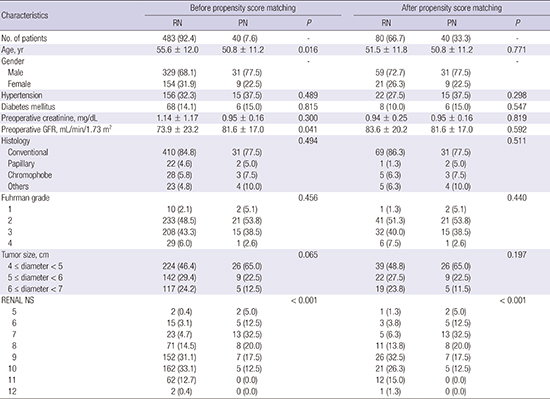1. Huang WC, Levey AS, Serio AM, Snyder M, Vickers AJ, Raj GV, Scardino PT, Russo P. Chronic kidney disease after nephrectomy in patients with renal cortical tumours: a retrospective cohort study. Lancet Oncol. 2006; 7:735–740.
2. Thompson RH, Boorjian SA, Lohse CM, Leibovich BC, Kwon ED, Cheville JC, Blute ML. Radical nephrectomy for pT1a renal masses may be associated with decreased overall survival compared with partial nephrectomy. J Urol. 2008; 179:468–471.
3. Ljungberg B, Bensalah K, Canfield S, Dabestani S, Hofmann F, Hora M, Kuczyk MA, Lam T, Marconi L, Merseburger AS, et al. EAU guidelines on renal cell carcinoma: 2014 update. Eur Urol. 2015; 67:913–924.
4. Brewer K, O’Malley RL, Hayn M, Safwat MW, Kim H, Underwood W 3rd, Schwaab T. Perioperative and renal function outcomes of minimally invasive partial nephrectomy for T1b and T2a kidney tumors. J Endourol. 2012; 26:244–248.
5. Badalato GM, Kates M, Wisnivesky JP, Choudhury AR, McKiernan JM. Survival after partial and radical nephrectomy for the treatment of stage T1bN0M0 renal cell carcinoma (RCC) in the USA: a propensity scoring approach. BJU Int. 2012; 109:1457–1462.
6. Weight CJ, Larson BT, Fergany AF, Gao T, Lane BR, Campbell SC, Kaouk JH, Klein EA, Novick AC. Nephrectomy induced chronic renal insufficiency is associated with increased risk of cardiovascular death and death from any cause in patients with localized cT1b renal masses. J Urol. 2010; 183:1317–1323.
7. Scosyrev E, Messing EM, Sylvester R, Campbell S, Van Poppel H. Renal function after nephron-sparing surgery versus radical nephrectomy: results from EORTC randomized trial 30904. Eur Urol. 2014; 65:372–377.
8. Kolla SB, Spiess PE, Sexton WJ. Interobserver reliability of the RENAL nephrometry scoring system. Urology. 2011; 78:592–594.
9. Canter D, Kutikov A, Manley B, Egleston B, Simhan J, Smaldone M, Teper E, Viterbo R, Chen DY, Greenberg RE, et al. Utility of the R.E.N.A.L. nephrometry scoring system in objectifying treatment decision-making of the enhancing renal mass. Urology. 2011; 78:1089–1094.
10. Waldert M, Klatte T. Nephrometry scoring systems for surgical decision-making in nephron-sparing surgery. Curr Opin Urol. 2014; 24:437–440.
11. Rosevear HM, Gellhaus PT, Lightfoot AJ, Kresowik TP, Joudi FN, Tracy CR. Utility of the RENAL nephrometry scoring system in the real world: predicting surgeon operative preference and complication risk. BJU Int. 2012; 109:700–705.
12. Simhan J, Smaldone MC, Tsai KJ, Canter DJ, Li T, Kutikov A, Viterbo R, Chen DY, Greenberg RE, Uzzo RG. Objective measures of renal mass anatomic complexity predict rates of major complications following partial nephrectomy. Eur Urol. 2011; 60:724–730.
13. Bruner B, Breau RH, Lohse CM, Leibovich BC, Blute ML. Renal nephrometry score is associated with urine leak after partial nephrectomy. BJU Int. 2011; 108:67–72.
14. Tomaszewski JJ, Smaldone MC, Mehrazin R, Kocher N, Ito T, Abbosh P, Baber J, Kutikov A, Viterbo R, Chen DY, et al. Anatomic complexity quantitated by nephrometry score is associated with prolonged warm ischemia time during robotic partial nephrectomy. Urology. 2014; 84:340–344.
15. Liu ZW, Olweny EO, Yin G, Faddegon S, Tan YK, Han WK, Cadeddu JA. Prediction of perioperative outcomes following minimally invasive partial nephrectomy: role of the R.E.N.A.L nephrometry score. World J Urol. 2013; 31:1183–1189.
16. Wang HK, Zhu Y, Yao XD, Zhang SL, Dai B, Zhang HL, Shen YJ, Wang CF, Ye DW. External validation of a nomogram using RENAL nephrometry score to predict high grade renal cell carcinoma. J Urol. 2012; 187:1555–1560.
17. Satasivam P, Sengupta S, Rajarubendra N, Chia PH, Munshey A, Bolton D. Renal lesions with low R.E.N.A.L nephrometry score are associated with more indolent renal cell carcinomas (RCCs) or benign histology: findings in an Australian cohort. BJU Int. 2012; 109:Suppl 3. 44–47.
18. Ohno Y, Nakashima J, Ohori M, Hashimoto T, Iseki R, Hatano T, Tachibana M. Impact of tumor size on renal function and prediction of renal insufficiency after radical nephrectomy in patients with renal cell carcinoma. J Urol. 2011; 186:1242–1246.
19. Satasivam P, Reeves F, Rao K, Ivey Z, Basto M, Yip M, Roth H, Grummet J, Goad J, Moon D, et al. Patients with medical risk factors for chronic kidney disease are at increased risk of renal impairment despite the use of nephron-sparing surgery. BJU Int. 2015; 116:590–595.
20. Song C, Bang JK, Park HK, Ahn H. Factors influencing renal function reduction after partial nephrectomy. J Urol. 2009; 181:48–53.
21. Volpe A, Amparore D, Mottrie A. Treatment outcomes of partial nephrectomy for T1b tumours. Curr Opin Urol. 2013; 23:403–410.
22. Motzer RJ, Jonasch E, Agarwal N, Beard C, Bhayani S, Bolger GB, Chang SS, Choueiri TK, Derweesh IH, Gupta S, et al. Kidney cancer, version 2.2014. J Natl Compr Canc Netw. 2014; 12:175–182.
23. Lesage K, Joniau S, Fransis K, Van Poppel H. Comparison between open partial and radical nephrectomy for renal tumours: perioperative outcome and health-related quality of life. Eur Urol. 2007; 51:614–620.
24. Sprenkle PC, Power N, Ghoneim T, Touijer KA, Dalbagni G, Russo P, Coleman JA. Comparison of open and minimally invasive partial nephrectomy for renal tumors 4-7 centimeters. Eur Urol. 2012; 61:593–599.
25. Shim M, Song C, Park S, Kim A, Choi SK, Kim CS, Ahn H. Hilar location is an independent prognostic factor for recurrence in T1 renal cell carcinoma after nephrectomy. Ann Surg Oncol. 2015; 22:344–350.
26. Kutikov A, Smaldone MC, Egleston BL, Manley BJ, Canter DJ, Simhan J, Boorjian SA, Viterbo R, Chen DY, Greenberg RE, et al. Anatomic features of enhancing renal masses predict malignant and high-grade pathology: a preoperative nomogram using the RENAL Nephrometry score. Eur Urol. 2011; 60:241–248.
27. Kopp RP, Liss MA, Mehrazin R, Wang S, Lee HJ, Jabaji R, Mirheydar HS, Gillis K, Patel N, Palazzi KL, et al. Analysis of renal functional outcomes after radical or partial nephrectomy for renal masses ≥7 cm using the RENAL score. Urology. 2015; 86:312–319.
















